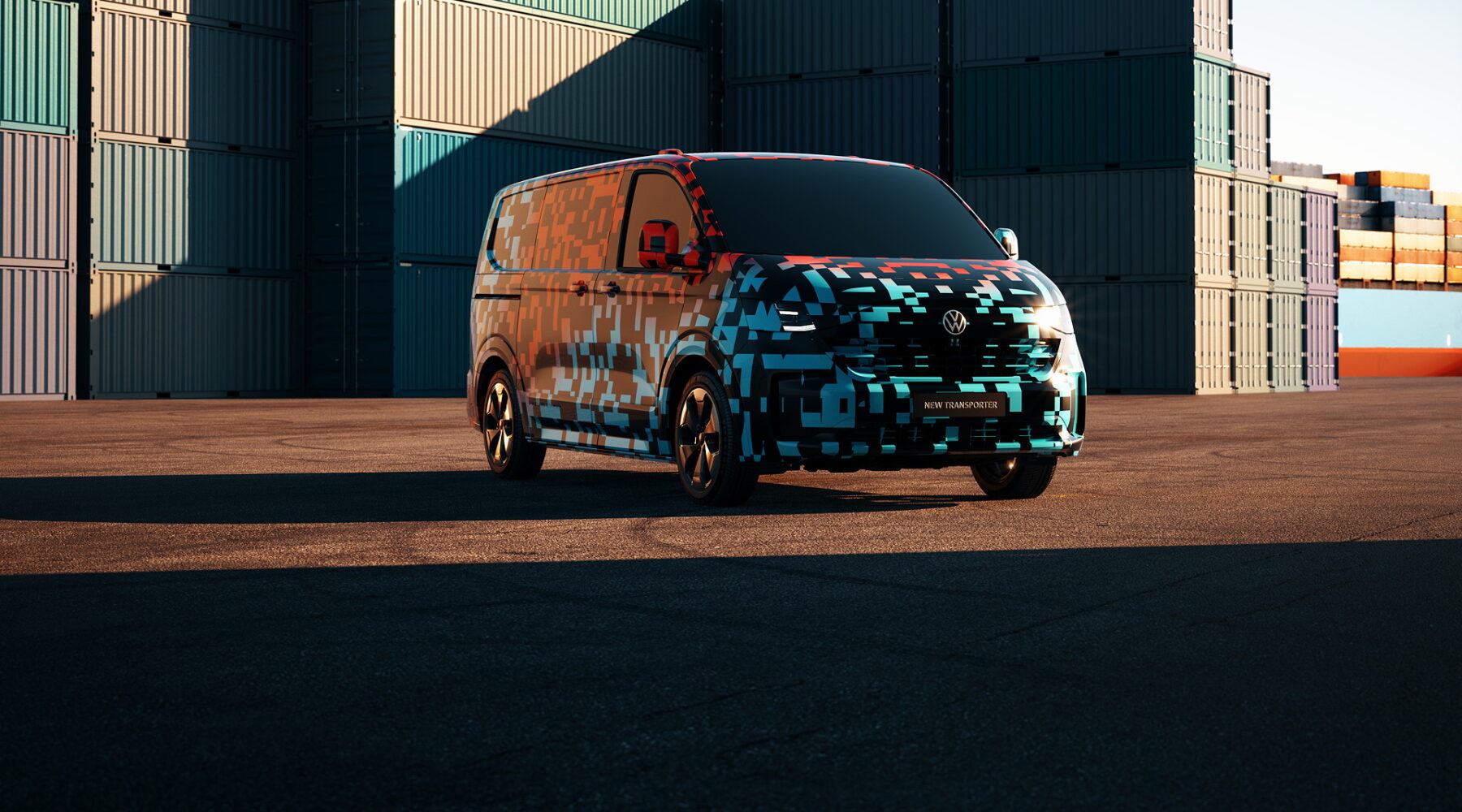
Interview | FleetTalk with Volkswagen Commercial Vehicles
“We find the right solution for the customer”
Throughout the year of 2024, Volkswagen Commercial Vehicles is conducting a product offensive that offers something new in all model series. In the following FleetTalk, Konrad Wagner, the Head of Sales for Fleet Customers in Europe and International, and Andreas Zenk, the Head of Sales for Fleet Customers in Germany, discuss the ways that customers will profit from these new products and enhancements.

Mr. Wagner, Mr. Zenk, you are the new heads of fleet customers in Europe and International and in Germany, respectively. Describe yourself in two sentences?
Konrad Wagner: After holding various sales positions at Volkswagen Commercial Vehicles in Hannover, I shifted to international business for the brand – and got to know the importer’s perspective. This perspective really helps me in my position as head of international fleet sales because I know how to optimally address the requirements of our customers together with our importers and their sales organisations.
Andreas Zenk: I became head of the fleet customer business in the German market at Volkswagen Commercial Vehicles this past April – and I am really excited about this new opportunity to work once again with Konrad Wagner. Both of us have worked together for years in sales and plan to better tap synergies between the German and international markets.

Which issues are you focusing on in particular?
Andreas Zenk: The biggest challenges continue to be delivery times for some of our products. These resulted in recent years from global crises and the related shortages of raw materials and components. At the same time, we received many orders in this period because we stood steadfast by the side of our fleet customers – in particular with our reliable pricing structure. We are now working intensely to fill these orders. Our plants are working at the limits of their capacity, and things are continuously improving.
Konrad Wagner: Another issue is becoming more important: Many companies want and have to increasingly carry out their own sustainability strategy and have a tremendous need for information and support as a result. First, in terms of the product range and, second, in terms of our company: How is Volkswagen Commercial Vehicles positioned? And how can we as a vehicle manufacturer support this customer strategy? These are just a few of the questions that we are intensely considering.
“This year, we are setting off the biggest display of product fireworks that Volkswagen Commercial Vehicles has seen in quite some time.”
Andreas Zenk
Head of Sales for Fleet Customers in Germany, Volkswagen Commercial Vehicles
What sort of new models and product enhancements can fleet customers expect to see this year?
Konrad Wagner: One of this year’s real highlights will certainly be the new Transporter that will make its world premiere at the IAA Transportation in September. We at the company have already had a chance to take a peek at the new van – together with selected customers. And what can I say? The feedback was extremely positive. Fleet customers really have something to look forward to. The new Transporter can be used in all sorts of ways thanks to its wide range of features. Simply its line of drive systems, ranging from the classic internal combustion engine to plug-in hybrid and electric motor, offers an entirely new type of variety. These power plants are complemented by various wheelbases and roof varieties. Added all together, these features turn the van into an allrounder. With the new Transporter, the trio consisting of the ID. Buzz, Multivan and the new Transporter is complete – and Volkswagen Commercial Vehicles provides every customer with the right vehicle to fit their individual needs.
Andreas Zenk: I would go even farther and say: This year, we are setting off the biggest display of product fireworks that Volkswagen Commercial Vehicles has seen in quite some time. In addition to the new Transporter we talked about, something is really happening in every model series. The time-tested Crafter has been attractively enhanced. An efficient plug-in hybrid has been added to the Caddy model. And, thanks to the ID. Buzz GTX, its new version with the extended wheelbase and the Multivan, Volkswagen Commercial Vehicles has become appealing to entirely new target groups.
Konrad Wagner: In particular, our multinational customers will be excited to learn that the Volkswagen Commercial Vehicle brand is expanding internationally beyond Germany and Europe – and that our electric vehicles, especially the ID. Buzz, will now be rolled out in other international markets. The model will be introduced to the Turkish and Australian markets this year, among other areas. We are also working on entirely new international markets. Our aim is to globally position the brand as a dependable partner.

Let’s take a closer look at another new model for a moment: Why does the new Crafter appeal so much to fleet customers?
Andreas Zenk: I think the Crafter is already the best vehicle in its segment. It is now being systematically improved even further by the inclusion of various product enhancements. The new free-standing dashboard makes it much easier for customers to use all of the digitalisation features offered by the vehicle. As a result of legal regulations like the UN-ECE and the GSR II, a large number of standard features that offer real added value during daily operations has been added to the model.
What role will the Multivan and ID. Buzz play in Volkswagen Commercial Vehicles’ future fleet strategy?
Andreas Zenk: That’s easy to answer: Both vehicles are perfectly designed to meet the individual needs of the user group called user-choosers and offer maximum room and variability.
Konrad Wagner: That’s right. We provide our fleet customers with features that classic passenger cars can only partially offer: more than five seats and lots of room for business luggage and surf boards. And our range of vehicles offers the right option for every driving profile or national legal regulation, things like no driving zones: classic internal combustion engines, plug-in hybrids and all-electric drive systems.
Andreas Zenk: In Germany, this means that our business customers will profit from attractive taxation, particularly in terms of the new valuation limit of the gross list price of €70,000.
“We will use our all-electric SPACE vehicle family to shape the future of Volkswagen Commercial Vehicles.”
Konrad Wagner
Head of Sales for Fleet Customers in Europe and International, Volkswagen Commercial Vehicles
What does the roadmap for the introduction of other plug-in hybrid and electric models look like?
Andreas Zenk: In addition to the Multivan, the Caddy can be ordered as a plug-in hybrid starting in the second half of the year.
Konrad Wagner: Looking farther ahead into the future, I would like to mention our planned e-platform called “Space,” something that will represent a real milestone both for us and our customers. We will use our all-electric SPACE vehicle family to shape the future of Volkswagen Commercial Vehicles. It will be based on our own modular commercial vehicle system that will enable use to efficiently design commercial vehicles for commercial and private target groups. In taking this step, we will move forcefully forward on our strategic path towards the electrification of our vehicle fleet and the reduction of CO₂ emissions. Based on current planning, we will develop and make the all-electric Crafter as the first vehicle in the SPACE vehicle family.
The number of market players, in particular for electric vehicles, is growing and thus the selection for customers …
Andreas Zenk: It is true that the range of light electric commercial vehicles is rather limited in comparison with passenger car segments. With the help of our e-strategy and upcoming models, we have improved our positioning step by step.
Regardless of whether you are talking about e-vehicles, internal combustion engines or plug-in hybrids: Why should fleet customers choose Volkswagen Commercial Vehicles in the first place?
Andreas Zenk: Let me mention two reasons. As part of the Volkswagen Group, we can devise the right vehicle offer to meet individual fleet needs. We can also put together an attractive overall package in Germany: We have a wide network of dealers that is much more closely knit than the networks of other market players. We offer very good after-sales solutions and are becoming digitalised on step-by-step basis. We are also working in close cooperation with reliable modification partners and body manufacturers in Germany. Customers get everything they need from a single source: Volkswagen Commercial Vehicles.
Konrad Wagner: Our customers’ needs are extremely wide and differ from country to country – for example, business conditions in Scandinavia differ from those in southern Europe. We search for the best solutions for our customers across all sales steps.
How is digitalisation changing interaction with customers?
Konrad Wagner: Vehicle digitalisation and the provision of an appropriate digital eco-system are elementary. This involves both seamless interaction by customers with us as a brand and with our products and services. In future, we plan to enable our B2B customers to manage their fleets more efficiently and better meet their individual needs. Let me expand on this for a minute.
Our Connect Pro is a comprehensive portal for fleet management. With the help of such functions as over-the-air updates, real-time localisation, infotainment services and intelligent maintenance management, it facilitates smooth management of Volkswagen Commercial Vehicle fleets.
Looking ahead, we are working on interfaces that fleet customers can use to integrate selected vehicle data into their existing fleet management systems without using other telematic solutions. One other possibility is to expand the interface for managing selected vehicle functions. These areas are becoming more and more relevant for our customers, and we will now roll out these services step by step.
Andreas Zenk: Let me mention something else in this regard: Thanks to central monitoring and management of vehicles, down times can be reduced and fleet operational readiness increased. When a company car breaks down, this is naturally an unpleasant experience for the user. But the vehicle is fairly easy to replace. But you face a different challenge if you are talking about a vehicle modification job done in the service centre. Our services are designed to effectively reduce downtime, something that is a major plus for customers.

How do current and future legal changes, particularly those in the area of emission policy, impact the fleet strategy of Volkswagen Commercial Vehicles?
Andreas Zenk: One thing is clear about regulations: We need reliable and binding requirements from political leaders. The automotive industry is long cyclic, and we cannot rethink our decisions every three or four years. We have invested large sums of money and are working to make every new vehicle in Europe all electric starting in 2035. For us at Volkswagen Commercial Vehicles, this means that we must remain committed to our electric strategy. In this phase of transformation, one of our customers’ top priorities is for us to offer a flexible range of drive systems because, first, regions around the world are developing at different paces and, second, use by our customers varies. Such factors as range, capacity and towing capacity currently are the critical areas when customers select a drive system concept. Let’s say a customer is looking for a vehicle with 3.5 tons of unladen weight, maximum range and maximum capacity. Such customers currently tend to select an internal combustion engine. But if you are talking about urban delivery transports, an electric vehicle will most likely better meet your needs.
Konrad Wagner: You can probably sum things up this way: We find the right solution for every customer. If the usage profile is not suited for an electric solution at the moment, we will find an alternative in our line of drive systems that will facilitate the transition.
Both of you can look back on many years of experience in sales at Volkswagen Commercial Vehicles – how are you experiencing the transformation of the fleet business and what do you expect to see in coming months?
Andreas Zenk: You feel a tremendous dynamism, both in terms of technical developments and the market situation and thus the challenges that arise as a result. We have to find new answers to the needs of our fleet customers over and over again. Amid all of these changes, we should do nothing that would upset our most critically important success factor: our loyal and trusting relationship with our customers and our dealership partners.
Konrad Wagner: The last few years were particularly challenging for well-known reasons. But I think that we are seeing a significant improvement and are returning to normality, a normality that includes different business conditions and requirements. It is our job to build these new factors into our offerings and remain a reliable partner at the same time. We are looking forward to the future – and I think our customers are, too.
All information applies to the German market.
Status: 14.06.2024
© Volkswagen AG









